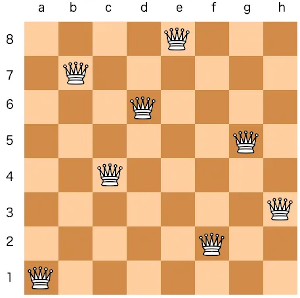output = queens(4, 4)
print(sorted(output))
print()
output = queens(6, 5)
print("output is of type", type(output))
print("output has size:", len(output))
for x in sorted(output): print(x)
|
[[2, 4, 1, 3], [3, 1, 4, 2]]
output is of type
output has size: 40
[1, 3, 5, 2, 4]
[1, 4, 2, 5, 3]
[1, 5, 2, 6, 3]
[2, 4, 1, 3, 5]
[2, 4, 6, 1, 3]
[2, 4, 6, 1, 5]
[2, 4, 6, 3, 5]
[2, 5, 1, 6, 4]
[2, 5, 3, 1, 4]
[2, 5, 3, 6, 4]
[2, 6, 1, 3, 5]
[2, 6, 3, 1, 4]
[3, 1, 4, 2, 5]
[3, 1, 6, 2, 5]
[3, 1, 6, 4, 2]
[3, 5, 2, 4, 1]
[3, 5, 2, 4, 6]
[3, 6, 2, 5, 1]
[3, 6, 4, 1, 5]
[3, 6, 4, 2, 5]
[4, 1, 3, 5, 2]
[4, 1, 3, 6, 2]
[4, 1, 5, 2, 6]
[4, 2, 5, 3, 1]
[4, 2, 5, 3, 6]
[4, 6, 1, 3, 5]
[4, 6, 1, 5, 2]
[4, 6, 3, 5, 2]
[5, 1, 4, 6, 3]
[5, 1, 6, 4, 2]
[5, 2, 4, 1, 3]
[5, 2, 4, 6, 3]
[5, 2, 6, 1, 3]
[5, 3, 1, 4, 2]
[5, 3, 1, 6, 2]
[5, 3, 1, 6, 4]
[5, 3, 6, 4, 2]
[6, 2, 5, 1, 4]
[6, 3, 5, 2, 4]
[6, 4, 2, 5, 3]
|
 Dr. Zoidberg has been given an intriguing puzzle to solve. He's been tasked with placing exactly C queens on a chessboard with R rows and C columns. He needs to know all the possible ways to place these queens on the board, such that no two queens can attack each other.
Dr. Zoidberg has been given an intriguing puzzle to solve. He's been tasked with placing exactly C queens on a chessboard with R rows and C columns. He needs to know all the possible ways to place these queens on the board, such that no two queens can attack each other.